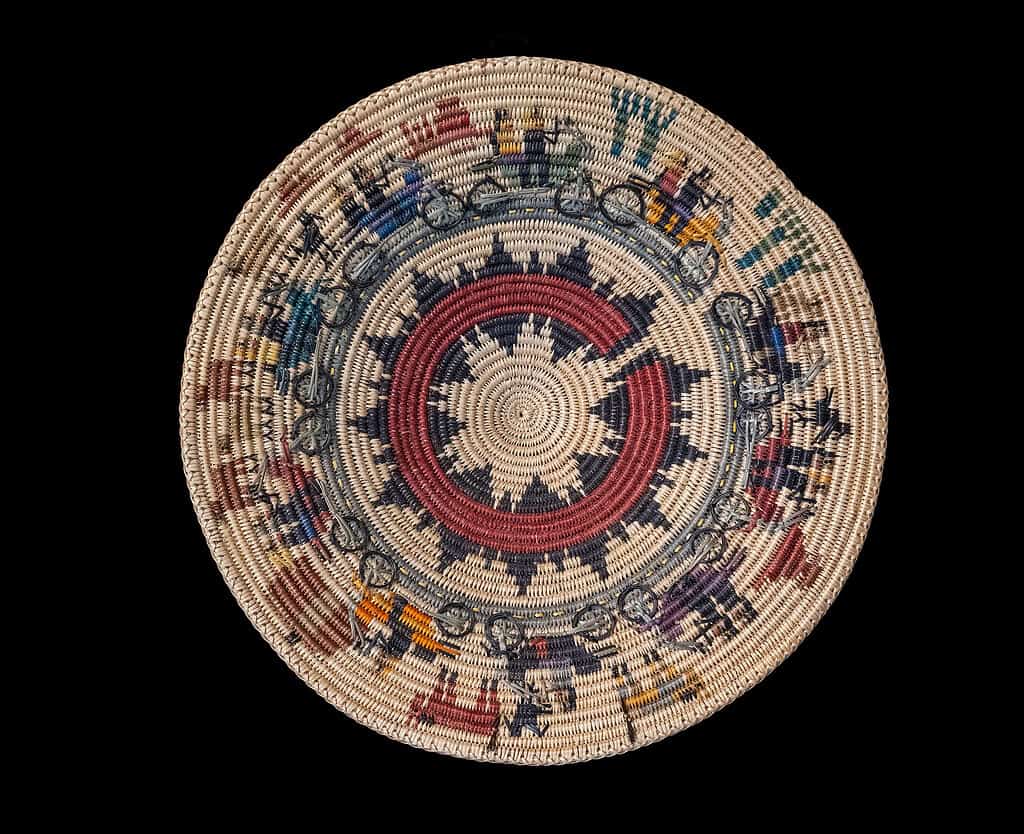Some information may be outdated.

The Museum is proud to exhibit ten striking baskets from the Twin Rocks Trading Post Collection for one month following our annual winter closure, until February 10th.
Before there were Rugs
According to Navajo oral history, the earliest weaving began in basketry. Baskets (ts’aa’) were made from three-leafed sumac for domestic and ceremonial use using a two-rod coiling method. Baskets are used in several ceremonial ways: to hold ritual objects such as prayer sticks and medicine bundles; to hold yucca suds for ritual hair washing and baths; as drums when inverted and struck with a yucca drum stick; to hold food during the Navajo wedding ceremony when cornmeal is eaten; and to hold ground white clay, red ochre, and cornmeal during the coming of age ceremony and many other uses.
These baskets on display, which take the place of the traveling Utah Division of Arts and Museums (UDAM) exhibit Weaving the Future, are on loan to the Museum from the Twin Rocks Trading Post Collection located in Bluff, UT. “The Twin Rocks Trading Post Collection comprises nearly 250 remarkable baskets woven by members of the Navajo Nation from the Utah Strip of the Navajo reservation. The Collection illustrates the extraordinary renaissance of the art of Navajo basket weaving, an art form practiced by only a few Utah weavers and virtually unknown by Navajos elsewhere on the reservation” (Weaving a Revolution: Celebration of Contemporary Navajo Baskets by the Natural History Museum of Utah).
Steve Simpson, owner of Twin Rocks, and the Simpson family have been collecting baskets for four decades. According to the Twin Rocks Trading Post website the family “shares his [Steve’s] passion for cultural tradition and artistic innovation with local artists and visiting collectors alike.” The Natural History Museum of Utah (NHMU) featured more than 150 of these works in their exhibition Weaving a Revolution, between January and April 2013. The ten striking baskets featured at the Moab Museum were not included in this exhibition, however, and have only been displayed at Twin Rocks.

About the NHMU exhibit
“Weaving a Revolution featured more than 150 works of art created over the past thirty years by basket makers from the Monument Valley, Utah area. Today, they make traditional ceremonial baskets as they always have, but have also created an explosion of design and imagery enthusiastically embraced by both the international art market and fellow Navajos who are aware of this work. Swirling with geometric patterns, stylized plants and animals, and the sacred beings of origin stories, the baskets pay tribute to the past, preserve tradition, and honor creativity.”
Stop by following our annual winter closure, which concludes on January 16th, to view these incredible works of art, learn about the artists who created them, and more about the evolution of basketry to textile weavings in Navajo (Diné) culture.
The Moab Museum is dedicated to sharing stories of the natural and human history of the Moab area. To explore more of Moab’s stories and artifacts, find out about upcoming programs, and become a Member, visit www.moabmuseum.org.
Appreciate the coverage? Help keep local news alive.
Chip in to support the Moab Sun News.





